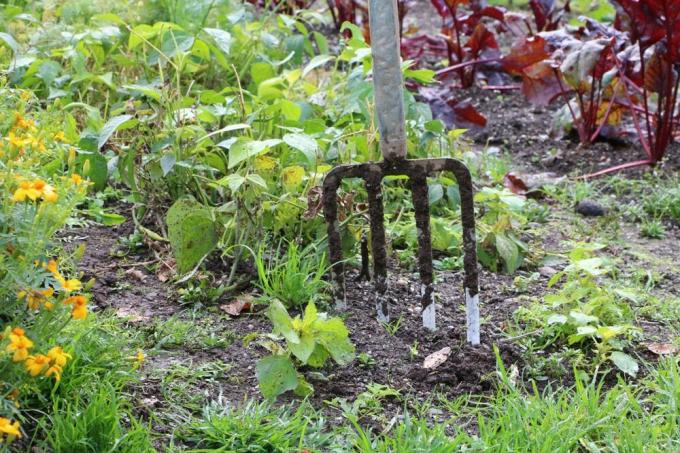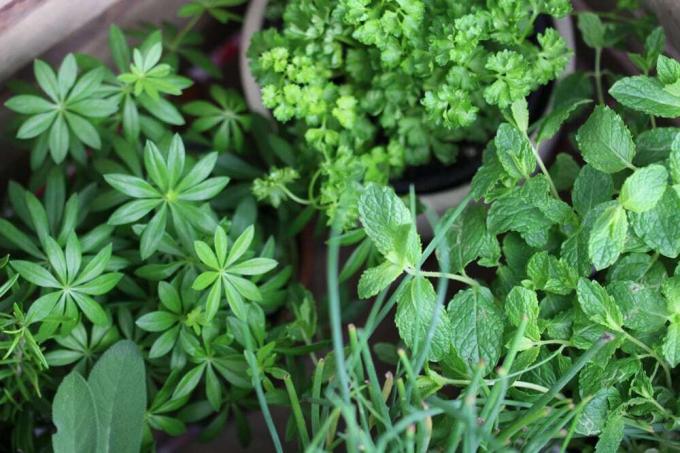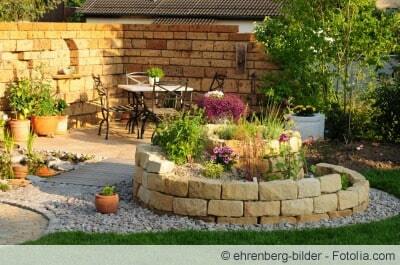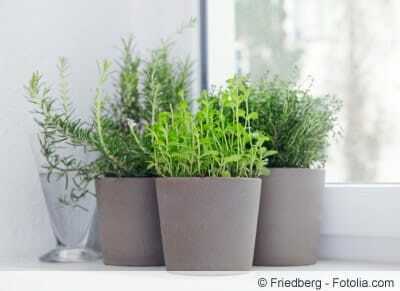

Table of contents
- Location
- classic
- wild bed
- herb mound
- herbal spiral
- raised bed
- Portable bed
She is also discovering more and more German cuisine – herbs. No wonder: They are not only extremely tasty, but also healthy. Above all, they provide that certain kick in many dishes. In a self-built bed, many herbs can be easily grown in the garden. And at the same time, a modern design provides new and attractive visual accents.
Location
Anyone considering creating their own bed for herbs in the garden or building, of course, cannot avoid one question: Where should it go? The answer to this question, however, depends on which herbs are to be grown. The site conditions for the plants simply have to be right - and under certain circumstances they can be extremely different. Of course, the space requirement is also important. Although this is usually limited in herb beds, it increases with the number of herb species that are to be cultivated. Basically, a location near the kitchen or near a garden path is always recommended. This makes it much easier to quickly get fresh herbs for cooking.
classic
A bed for herbs can of course be created just like any other bed. The classic is the rectangular shape with a width of about 1.20 meters. Usually there are several beds next to each other, separated only by narrow paths. In principle, this system also works with herbs. However, hardly anyone will fill an entire bed with just parsley or parsley. planting with a single type of herb, usually only relatively small amounts are needed. Consequently, it is advisable to break up the classic variant a bit and generously equip the herb bed with several different plants. The best way to do this is to think about a system for distributing the plants. For example:
- Subdivision into plant strips
- Division into grid squares
- a circular division
- a wild mess
While the latter may be visually appealing, it can make harvesting a particular type of herb quite difficult. The division of the bed into individual squares is at least as attractive. Exactly one type of herb is then planted in each square. This makes searching and, above all, removal much easier.
Tip:
In the case of a square division, the bed also gains if the spaces in between or Boundaries can be laid out with stones or wooden elements. Small natural stones such as granite or pebbles are particularly recommended here.
wild bed

Many of our gardens today look incredibly orderly and almost clinically clean. But that has very little to do with nature. This often sterile impression can be counteracted with freely laid out herb beds without chaos having to take hold in the garden. Two factors benefit you here: on the one hand, herb beds require little space, on the other hand, herbal plants are usually pretty to look at and characterized by a natural beauty. So why not create a small, wild bed with herbs in the otherwise super well-kept lawn!? A circle diameter or an edge length of one meter is often sufficient for this. It is also conceivable to remove a paving slab from a garden path and plant herbs in the free space. Both may sound unusual and modern, but they have a great relaxing effect.
Tip:
With a distance of 10 to 15 centimeters between the lawn and the bed, there are no problems mowing the lawn. A demarcation with stones or narrow wooden planks is also conceivable.
herb mound
One of the herb bed ideas that will definitely make an impression is undoubtedly the herb hill. The name says it all. At a suitable spot in the garden, soil is simply piled up to form a small hill. Sand can also be used as a basis, but it is better to work with garden soil throughout. It is important to provide the base of the mound with a drainage of pebbles, and additionally fix it with stones. This prevents slipping. The entire hill is then simply planted all around with different herbs. In this way you can bring a piece of wild nature into the garden with very little effort, which quickly becomes an eye-catcher.
herbal spiral
There is also a bit of the hilltop idea in the herb spiral. This bed is basically also oriented upwards. Delimited by natural stones, the relatively narrow planting area spirals upwards. From an aesthetic point of view, this slightly different bed shape is undoubtedly a hit. It may take some time to build, but it's definitely worth it. In contrast to the herb hill, the planting area itself is not sloping, but rather straight. It should be noted during construction that the stones used are as tight as possible and cannot slip off. This could damage the herbs growing beneath them. The stones should therefore be knocked down and lie flat. Incidentally, such a spiral can also be created at ground level.
raised bed

With many herbs, only individual leaves are often harvested. For example, while the entire plant is pulled out of the ground with radishes, with herbs often only individual elements have to be cut off. This may take some time. So it makes sense not to have to bend down too deeply. A raised bed is therefore ideal for growing herbs. It doesn't even have to be very big. An area of one square meter is usually completely sufficient. A height between 90 and 110 centimeters has proven to be ideal for most people. How to build:
- Screw together the bed box made of wooden boards and square timber
- Leave openings at the top and bottom
- Provide wood with a weatherproof glaze
- Spend box to location
- fill in layers
The filling begins with a first layer of about 20 centimeters of coarse tree, shrub or hedge clippings. This is followed by a layer of bark mulch, also around 20 centimeters thick, on which a similarly thick layer of leaves or grass clippings is placed. This is followed by 15 to 20 centimeters of half-ripe compost or horse manure. Finally, another approximately 20 centimeters thick layer of humus and garden soil is applied.
Portable bed
One of the great advantages of growing herbs is that they require a relatively large amount of space. The cultivation of herbs therefore seems quite modern, for example if it takes place in an old fruit crate or a discarded chest. In this way you get a portable bed that can be placed at different locations in the garden, on the terrace or on the balcony. This can be extremely useful, especially in extreme weather conditions. In addition, new accents can always be set in the garden. The crate or chest can of course be designed to your heart's content. There shouldn't be a shortage of ideas. The only important thing is that there are smaller holes on the bottom to prevent water from accumulating. If necessary, these must first be drilled.
 garden editorial
garden editorial I write about everything that interests me in my garden.
Learn more about herb garden

Mortar tub as a plant pot and herb bed
Mortar trays from the well-stocked hardware store are the ideal alternative for quickly and easily on the patio or balcony to conjure up a small herb bed or tomatoes, peppers but also flowering plants cultivate. The tubs are available in different sizes and shapes and thus fit into the smallest corner.

Perennial herbs in the herb garden - list of hardy varieties
Herbs are very popular among hobby gardeners, and rightly so! Because the plants are not only versatile, but also usually perennial and hardy! You can find out here which varieties you should definitely grow in your herb bed!

The best two herb snail building instructions
From the dry zone to the swamp area, the right climate zone for every herb. All of this in just three square meters. With a herb snail, you can create this small natural wonder, a so-called permaculture, in your own garden. There are multiple varieties and appearances and sizes, all of which follow basically the same building instructions.

Creating a herb snail – instructions in 6 steps
With a herb snail, fresh kitchen herbs are always on the table, and they also have a high decorative value in the garden. The attractive herb bed in the form of a spiral grows upwards like a snail and therefore allows the planting of many different herbs with different demands on each Location.

Lavender varieties - hardy species for the garden
Robust, strongly scented and used in the kitchen and as a remedy, everyone knows lavender. But be careful, because not all of the many varieties of lavender are suitable for cultivation in your garden bed at home. Because there are only a few varieties that are hardy and can survive a winter in the local latitudes outside.

Grow herbs and spices in the apartment/kitchen
Herbs and spices can also be easily grown in the home or in the kitchen if there is no garden available for cultivation. However, additional effort must be planned for maintenance. The site conditions are just as important here as in the herb garden, so that the herbs can thrive.



